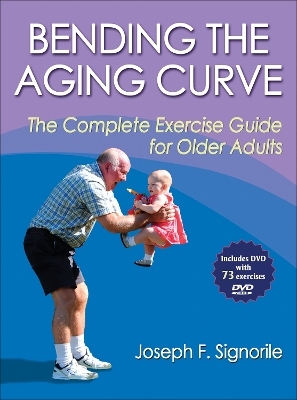
Bending the Aging Curve
Human Kinetics
978-0-7360-7445-2 (ISBN)
As we age, it’s natural to see some loss of strength, flexibility, balance, and aerobic endurance. But today’s aging population isn’t willing to just sit back and accept these declines. They’re looking for ways to maintain a high quality of life throughout their older years. Bending the Aging Curve: The Complete Exercise Guide for Older Adults offers a systematic approach to designing exercise programs that will help older adults bend or straighten these curves of decline, resulting in more years of strength, vitality, and independence.
Bending the Aging Curve provides fitness professionals with a multifaceted periodized training program specifically for older adults. With this book and DVD package, you will find the tools you need to help your clients slow the physical decline that can accompany aging:
•Training strategies for improving body composition, flexibility, bone density, muscular strength and power, and cardiovascular fitness that can be customized to fit each client
•73 translational exercises that simulate everyday activities and help older clients to translate their new strengths into improved daily function and increased independence
•A series of tests that will allow you to assess your clients’ strengths and weaknesses, design programs that address their needs, and keep them motivated during their training
•A spreadsheet in which you can record clients’ test results and view their percentile rankings for their sex and age groups
•Videos of the translational exercises that let you and your clients see these unique activities in action to ensure accuracy and safety
•Video case studies of four sample clients that show the progression from testing to targeted training to the translational exercise cycle to help you understand how to design programs that meet your clients’ varying needs and goals
This one-of-a-kind resource presents a scientifically substantiated and practically proven training system that can extend the vitality of our aging population. Signorile offers an engaging explanation of the research behind his diagnosis and prescription model while maintaining a focus on the practical components of program design. You will learn to use tests to diagnose your clients’ needs and then prescribe training cycles with the appropriate mix of work, active recovery, and skill practice to maximize functional improvements. The photos and step-by-step instructions for each of the tests and exercises found in the book and the video clips on the DVD make it easy to quickly implement this training system with your clients.
Maintaining independence as we age depends on a multitude of factors. Bending the Aging Curve offers a comprehensive approach to designing exercise interventions that address all of these factors. With its targeted strategies, you’ll be able to help your clients stay active, energetic, and self-reliant, regardless of their age.
Joseph F. Signorile, PhD, is a professor in the department of kinesiology and sport sciences at the University of Miami in Coral Gables, Florida. He is a research health science specialist for the Miami VA Medical Center and has served as senior researcher at the Stein Gerontological Institute of the Miami Jewish Home and Hospital for the Aged. Dr. Signorile’s research interests include prescriptive periodization training for older individuals, diagnostic test development for exercise prescription, electromyographic analysis of sport- and activity-specific training, and evaluation of training techniques concentrating on power development. He has written over 50 refereed articles and book chapters and presented at countless national and international scientific and industry meetings. Dr. Signorile is a member of the University of Miami graduate faculty and serves on its research council and the graduate school committee for doctoral curriculum evaluation. He serves on the board of the International Council on Active Aging. He is also a member of the American College of Sports Medicine, the American Geriatrics Society, and the National Strength and Conditioning Association.
Part I: Understanding the Aging Curves and Training Older Adults
Chapter 1: The Aging Curves
The Concept of Age
The Diamond Analogy
The Aging Curves
Using Exercise to Bend the Aging Curves
Frailty and Physical Vulnerability
Prehab or Rehab: Changing the Oil or Changing the Engine?
Exercise as a Targeted Intervention: Matching the Program to the Need
Summary
Topical Bibliography
References
Chapter 2: Testing
The Exercise Diagnosis and Prescription Model
The Exercise Diagnosis: Analysis of Needs
What Makes an Effective Test?
When to Test
Testing Activities of Daily Living
Summary
Topical Bibliography
References
Chapter 3: Training Principles
Overload and Adaptation
Exercise Specificity
Summary
Topical Bibliography
References
Part II: Training Exercises: From Theory to Practice
Chapter 4: Body Composition
The Prevalence of Obesity and Its Consequences
The Obesity Paradox
Sarcopenic Obesity and Activities of Daily Living
Sarcopenic Obesity and Fall Probability
Testing Body Composition
Training Interventions for Sarcopenic Obesity
Summary
Topical Bibliography
References
Chapter 5: Flexibility
Defining Flexibility and the Stress–Strain Curve
Possible Causes of Declining Flexibility With Aging
Why Train for Flexibility?
Types of Stretching
Do Stretching and Flexibility Training Increase Flexibility?
Stretching, Flexibility Training, and Injury Prevention
Stretching, Flexibility Training, and Performance
Practical Aspects of Flexibility Training
Testing Flexibility
Flexibility Program Design
Flexibility Training Exercises
Summary
Topical Bibliography
References
Chapter 6: Bone, Falls, and Fractures
Structure of Bone
Factors Affecting Bone Strength
Osteopenia and Osteoporosis
Exercise Training to Prevent Osteoporosis
Better Balance and Agility
Testing Balance
Balance Training
Summary
Topical Bibliography
References
Chapter 7: Muscular Strength, Power, and Endurance Training
Sarcopenia: What Makes It Happen?
Effects of Resistance Training on the Causes of Sarcopenia
Resistance Training to Reduce the Effects of Sarcopenia
Testing Neuromuscular Performance
Resistance Training Exercises
Summary
Topical Bibliography
References
Chapter 8: Cardiovascular Training
Increasing Cardiovascular Fitness: Benefits and Methods
Testing Cardiovascular Fitness
Cardiovascular Training and Program Design
Summary
Topical Bibliography
References
Part III: Putting the Program Together
Chapter 9: Periodized Training
Periodization: The Underlying Theories
Fatigue During Time-Based Training Cycles
Controlling the Fitness–Fatigue Balance During Training
Applied Periodization Using Specific Training Cycles
Summary
Topical Bibliography
References
Chapter 10: The Translational Cycle: Active Recovery Meets Functional Practice
Basic Concept of the Translational Cycle
Translational Cycles and Periodization
Timing of Translational Cycles
Motor Learning Drills: The Need for Progression
Matching Translational and Training Cycles
Translational Exercises
Summary
Topical Bibliography
References
| Verlagsort | Champaign, IL |
|---|---|
| Sprache | englisch |
| Maße | 216 x 279 mm |
| Gewicht | 907 g |
| Themenwelt | Sachbuch/Ratgeber ► Gesundheit / Leben / Psychologie |
| Sachbuch/Ratgeber ► Sport ► Fitness / Aerobic / Bodybuilding | |
| Medizin / Pharmazie ► Medizinische Fachgebiete ► Geriatrie | |
| Studium ► 1. Studienabschnitt (Vorklinik) ► Histologie / Embryologie | |
| ISBN-10 | 0-7360-7445-7 / 0736074457 |
| ISBN-13 | 978-0-7360-7445-2 / 9780736074452 |
| Zustand | Neuware |
| Informationen gemäß Produktsicherheitsverordnung (GPSR) | |
| Haben Sie eine Frage zum Produkt? |
aus dem Bereich
